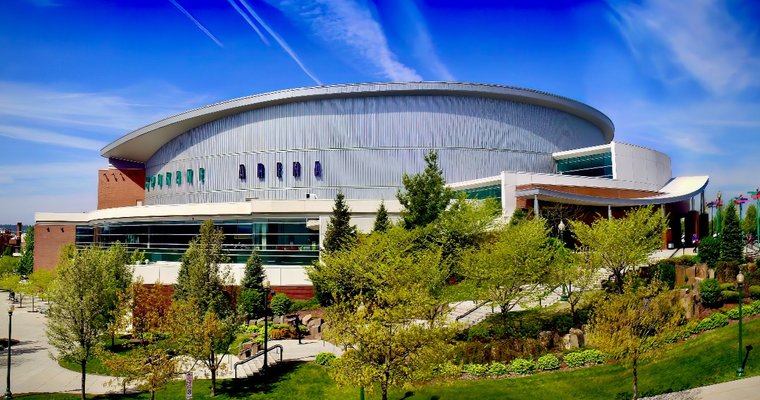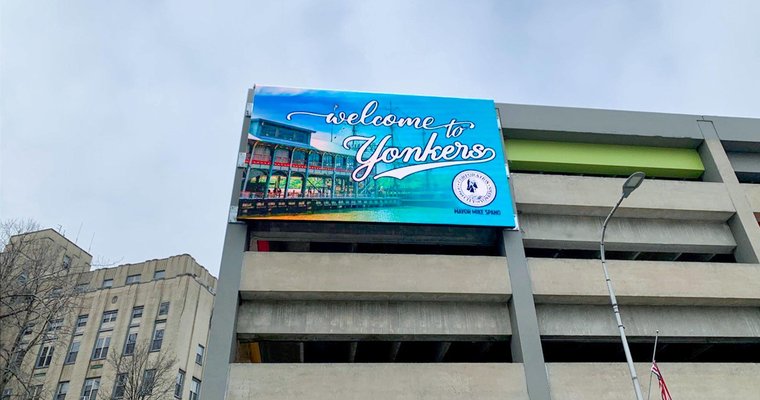
[ad_1]
Ryan Gallagher, digital display manager for Spokane Public Facilities District, joined Digital Signage Today via video link from his office at Spokane Arena, sharing principles and stories from his two decades of digital signage innovation.
 Exterior shot of Spokane Arena. Image provided by Spokane PFD.
Exterior shot of Spokane Arena. Image provided by Spokane PFD.
It’s no secret that event venues are at the frontlines of cities seeking to recover after the impact of pandemic lockdowns, but as concert goers and sports fans congregate, it takes a robust digital signage and DOOH network to serve these crowds.
Ryan Gallagher, digital display manager for Spokane Public Facilities District, joined Digital Signage Today via video link from his office at Spokane Arena, sharing principles and stories from his two decades of digital signage innovation, from birthday cake with Taylor Swift to emergency software troubleshooting for a jammed mid-game hockey replay for a live sports broadcast.
 |
Digital signage features prominently behind singers at Spokane Arena during NKOTB Mixtape Tour. On the right, a fan sign reads “Any Wahlberg will do.” Image provided by Spokane PFD. |
Spokane’s unique venue solution
This is vital to the city and its five major venue facilities (including Spokane Arena). In the mid ’90s, Spokane created a special taxing entity, the Spokane Public Facilities District (PFD), to help with renovating its then-outdated arena.
The PFD was designed to be “its own taxing entity, where its entire focus is maintaining the new arena, funding it and operating it,” Gallagher said. “It’s not with the city, it’s kind of city-adjacent. We’re a municipal corporation. All of the money that the PFD makes stays within the PFD. All of that money is then put back into repairs, maintenance and so on.”
A common misconception is that the venue is making large profits from events, but Gallagher says that’s inaccurate. “There is a small percentage that is made by the PFD. All the rest of that goes to the promoters and whatnot, and what the city receives in benefit is the economic impact of the restaurants, the hotel/motel stays and things like that. The facilities here are more of a loss leader to bring outsiders into the area to stay in it. Our number one priority is to drive economic opportunities where they normally wouldn’t exist.”
The variety of events means constant evolution; for example, the arena is beloved by local hockey players because it uses a special type of ice made with purified water. But when the U.S. figure skating championships required the ice to be at a different temperature from hockey usage, a team of ice technicians had to constantly monitor the ice with temperature guns to keep the surface right so that skaters could make jumps and the blades could cut into the ice properly. The same system had to be built with fail-safes in case of power failure, which happened one year when vandals tampered with a power substation and the ice began melting. The drainage system prevented catastrophic flooding, though replacing the ice ended up being very expensive.
 |
Shinedown performs at Spokane Arena. Image provided by Spokane PFD. |
Agility fuels success
Like so many in pro-AV and digital signage, Gallagher credits his ability to adapt to these constantly shifting challenges to his unconventional, wide-ranging career path. “I was always into computers and tech stuff growing up,” Gallagher said. “I have a minor background in graphic design, but I wouldn’t say that’s my passion. I’m just one of those people — whatever I find interesting, I like to learn about it.” As a part-time polymath, his latest at-home experiment is self-taught home remodeling.
A self-avowed “bleeding-edge early adopter” of emerging technology, Gallagher says his love for technology and innovation has been another core tool amid the sweeping changes in digital signage of recent years. He’s commonly been chosen to beta-test hardware and software at jobs, and he sometimes finds himself testing new technology at home to learn whether it has a place in workplace innovations. This has helped him lead transitions at the arena to sustainable practices like going fully LED, along with building towards a smart signage ecosystem inspired partly by the local power company’s efforts to build a smart grid for load balancing.
This instinct for innovation was made possible by the years Gallagher spent in digital signage and marketing, including working for a media agency with large DOOH networks that included digital billboards and outdoor signage. Learning how to be agile, adopt new technologies and build in smart automation everywhere possible has enabled him to streamline the digital signage network for Spokane Arena and the Spokane Public Facilities District network.
“I’ve actually been here for ironically 20 years part time, and I was in the tech department, so I was in the department that runs our video wall and so forth for the hockey games,” Gallagher said, listing the many working parts of game broadcasts, including goal wraps, scores, advertising, replays and more, along with events in the venue like concerts.
“So, if Journey’s here, I was the guy that was on hand in case something happened, if the internet went down, and it’s kind of a jack of all trades department where, most of the time, you’re kind of turning on the lights, making sure things are ready to go, but when things go bad, it’s bad — you’ve lost internet for half of the building and you can’t sell merchandise or food, or Cher needs a DVD player in her dressing room, so you’ve got to do that.”
 |
A Foo Fighters performance at Spokane Arena. Image provided by Spokane PFD. |
Choose your software carefully
Gallagher first encountered Omnivex software while working at Outfront Media, and he brought that experience to the software vetting process for Spokane.
Previous software solutions were becoming cumbersome, leading to a software hunt, and the team tried many options. “We went to a lot of companies,” Gallagher said. “I hadn’t even heard of Omnivex, and this product came in, and we put it through the paces.”
Gallagher said when he first saw the software, it didn’t look as aesthetically pleasing as some of the other tools his team had used. “I was kind of like, ‘it’s kind of ugly,’ it didn’t look polished… But once I started really looking at the product and seeing what it could do, I realized, ‘Oh, this is just the toolbox. I can make it look however I want.’ And this is just the back-end workhorse. As much as we tried to break the thing, it just held up,” he said.
When choosing technology, like software, Gallagher emphasizes the need for rigorous testing. He’s always been good at breaking things, he said, which is a good skill to have — for example, when nobody knows why the instant replay software has malfunctioned during a live CBS or ESPN NCAA broadcast, and the referees, players and fans are all waiting for the replay to inform the referee’s decision on a scoring issue.
That instinct for finding and fixing problems, along with crafting a culture of openness in your organization and with your vendors, is critical to success in the industry. “We’re not afraid of giving honest feedback,” he said, noting that his team is very open about documenting and sharing issues they find along with fixes, and communicating with a given vendor so that the product can be made better for all users.
Gallagher is swift to explain that he is loyal not to a given vendor but to efficiency. “I’m not paid by Omnivex, I’ve never received a dime from them, and we always said at Outfront Media, when/if another product came along that could beat it and make our efficiency better, we would switch in a heartbeat. It’s not about what’s running the system; it’s how efficient it can be to serve our customers and do it in a timely manner without changing the size of our team.
“And that was a major pride point for my former management — we kept our team extremely small,” Gallagher said, echoing a major theme across many IT departments tasked with digital signage duties. A similar small and agile ethos has shaped success for the public works department. “This is the type of place where you come and you don’t leave until you retire. It has a very small feel to it, even though they control some pretty substantial facilities. People like the work, it’s engaging, and you stay.”
 |
Exterior shot of Spokane Arena. Image provided by Spokane PFD. |
Be agile, embrace change, enjoy the journey
Automation and reliable, resilient software is vital to keeping small teams working well, according to Gallagher, along with being willing to embrace change. Enjoying the unexpected challenges and the lessons they bring, along with the good stories, is key to keeping good humor and a positive team spirit as the industry evolves, and creating a positive work culture is pivotal to retention.
When asked if he had any juicy celebrity stories to close with, Gallagher replied that that things are usually far too busy for such encounters at events, but he has had a few small interactions over the years. “You know, Taylor Swift came in — this was way before she was big — and she had brought in a birthday cake for somebody, and we had a small interaction. It’s kind of fun, but you’re around it so much it doesn’t phase you.”
 |
Agility is key in managing digital signage across five busy venues, including Spokane Convention Center (pictured). Image provided by Spokane PFD. |
Related:
Make it dance! The art and science of crafting a dynamic digital canvas | Digital Signage Today
Minneapolis-St. Paul airport’s digital transformation highlights signage, customer experience | Digital Signage Today
Daniel Brown is the editor of Digital Signage Today, a contributing editor for Automation & Self-Service, and an accomplished writer and multimedia content producer with extensive experience covering technology and business. His work has appeared in a range of business and technology publications, including interviews with eminent business leaders, inventors and technologists. He has written extensively on AI and the integration of technology and business strategy with empathy and the human touch. Brown is the author of two novels and a podcaster. His previous experience includes IT work at an Ivy League research institution, education and business consulting, and retail sales and management.
[ad_2]
Source link






